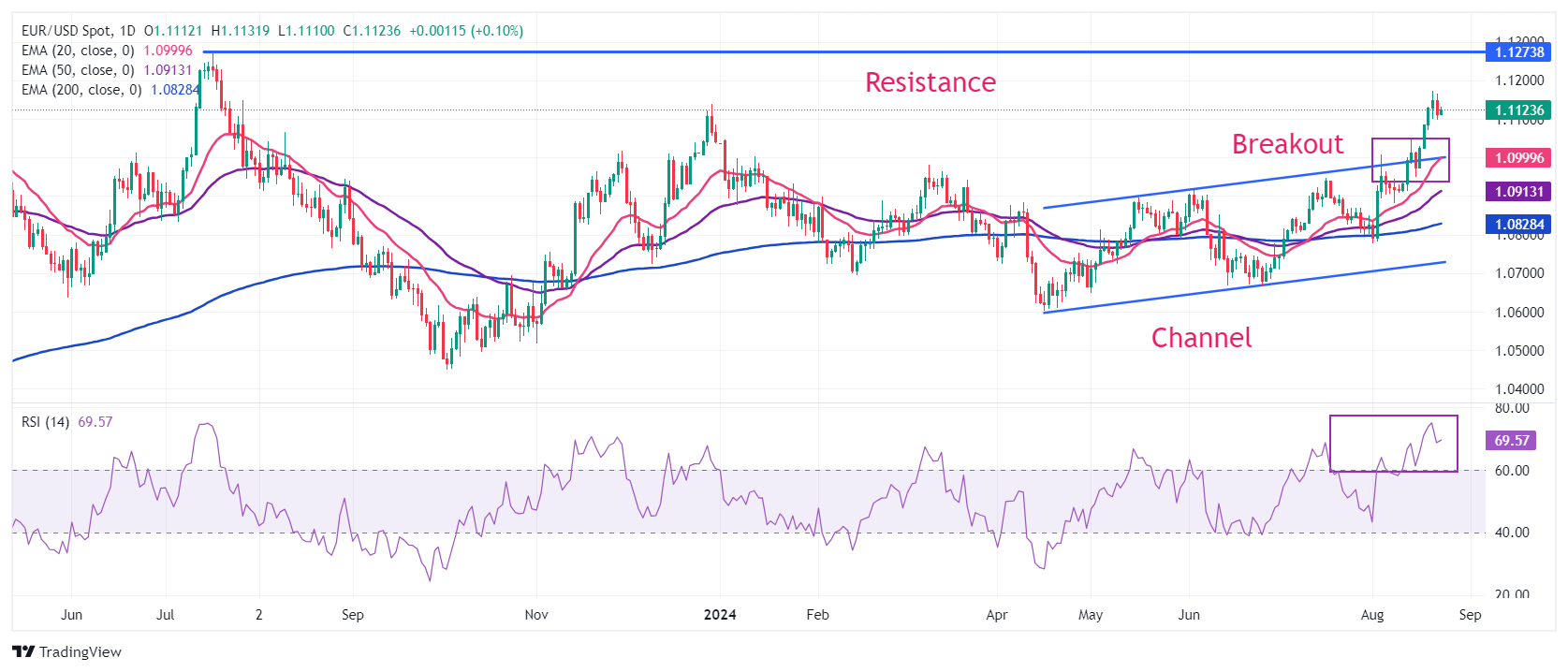- EUR/USD rises while US Dollar falls as traders focus on Fed’s Powell’s speech at the Jackson Hole Symposium.
- Investors are looking for new guidance on interest rates for September and the rest of the year.
- The ECB is widely expected to cut interest rates again in September.
EUR/USD rebounds slightly to near 1.1120 in the European session on Friday after correcting from a fresh yearly high of 1.1174 on Thursday. The major currency pair is higher as the US Dollar (USD) resumes its recent weakness after a decent recovery move a day earlier, amid caution ahead of Federal Reserve (Fed) Chair Jerome Powell’s speech at the Jackson Hole (JH) Symposium.
The US Dollar Index (DXY), which tracks the value of the greenback against six major currencies, is down near 101.30 after recovering from a more than seven-month low of 101.00 to nearly 101.60 on Thursday. The US Dollar rebounded strongly after the preliminary US S&P Global PMI report for August showed that the composite PMI came in better than estimated at 54.1. Overall, the report showed that business activity was boosted by a robust expansion in the services sector, while the manufacturing part of the economy contracted at a faster-than-expected pace.
In his speech at the JH Symposium, scheduled for 14:00 GMT, Jerome Powell is expected to provide clues on the US interest rates and economic outlook. Market participants are eager to know the size of interest rate cuts at the September meeting, given that a “large majority” of officials said that “if data continued to come in as expected, easing policy at the next meeting would likely be appropriate,” according to the minutes of the Federal Open Market Committee (FOMC) monetary policy meeting on July 30-31.
Investors are also considering the chances of the US economy achieving a “soft landing,” knowing that price pressures are on track to return to the desired 2% rate. Fears of a potential US recession intensified after the July Non-Farm Payrolls (NFP) report indicated a sharp slowdown in labor demand and a rise in the unemployment rate to 4.3%, the highest level seen since November 2021.
Analysts do not expect Jerome Powell to provide a pre-set interest rate path. However, he may consider rate cuts in September appropriate, given that risks have now expanded to both sides of the dual mandate (inflation and employment).
Daily Moves and Market Movers: EUR/USD Recovering Slightly as US Dollar Corrects
- EUR/USD is rising from the 1.1100 round-level support as investors support the Euro (EUR) against the US Dollar. However, the Euro is underperforming other major pairs as markets increasingly expect the European Central Bank (ECB) to cut interest rates again in September.
- Rising expectations of ECB rate cuts in September are supported by uncertainty over the Eurozone economic outlook and easing wage pressures.
- The preliminary Eurozone HCOB PMI report for August, released on Thursday, rose to a higher-than-expected 51.2, indicating that overall business activity expanded at a faster pace. However, this upbeat picture pointed out by the PMI surveys was linked to strong demand from the Olympic Games in Paris and is likely to be short-lived rather than structural. Uncertainty about economic performance in the coming months therefore remains intact.
- The PMI data also noted that business activity in the Eurozone’s largest economy, Germany, declined sharply mainly due to a significant drop in foreign demand, with no recovery in sight, pointing to the need for fresh stimulus to boost demand.
- Meanwhile, a sharp drop in second-quarter negotiated wage rates boosted hopes for more ECB rate cuts this year. The data, which was released in European trading hours on Thursday, showed negotiated wage rates grew at a slower pace of 3.55% from 4.74% in the first quarter of this year, easing fears that inflation remains persistent.
- Economists at ING said in a note on Thursday, “The European Central Bank has remained uncomfortable with cutting interest rates while wage growth is elevated.” Slower wage growth in the second quarter should help ease policymakers’ concerns on this issue.
Euro Price Today:
Euro PRICE Today
The table below shows the exchange rate of the Euro (EUR) against major currencies today. The Euro was the strongest currency against the Swiss Franc.
| EUR | USD | GBP | JPY | CAD | AUD | NZD | CHF | |
|---|---|---|---|---|---|---|---|---|
| EUR | 0.09% | -0.08% | -0.36% | -0.08% | -0.17% | -0.13% | 0.19% | |
| USD | -0.09% | -0.17% | -0.44% | -0.16% | -0.25% | -0.45% | 0.11% | |
| GBP | 0.08% | 0.17% | -0.27% | 0.02% | -0.09% | -0.03% | 0.03% | |
| JPY | 0.36% | 0.44% | 0.27% | 0.25% | 0.17% | 0.20% | 0.31% | |
| CAD | 0.08% | 0.16% | -0.02% | -0.25% | -0.09% | -0.04% | 0.04% | |
| AUD | 0.17% | 0.25% | 0.09% | -0.17% | 0.09% | 0.05% | 0.11% | |
| NZD | 0.13% | 0.45% | 0.03% | -0.20% | 0.04% | -0.05% | 0.06% | |
| CHF | -0.19% | -0.11% | -0.03% | -0.31% | -0.04% | -0.11% | -0.06% |
The heatmap shows percentage changes of major currencies. The base currency is selected from the left column, while the quote currency is selected from the top row. For example, if you choose the Euro from the left column and move along the horizontal line to the US Dollar, the percentage change shown in the chart will represent EUR (base)/USD (quote).
Technical Analysis: EUR/USD holds above 1.1100
EUR/USD is holding above the round-level support of 1.1100, with investors focused on Fed’s Powell’s speech at the JH Symposium. The outlook for the shared currency pair has remained bullish after a breakout of a channel formation on a daily time frame. All short- to long-term exponential moving averages (EMAs) are sloping upwards, suggesting a strong uptrend.
The 14-day Relative Strength Index (RSI) is hovering in the bullish range of 60.00-80.00, touching overbought levels but still suggesting strong upside momentum.
In case of a decisive break above the December 28, 2023 high at 1.1140, the Euro bulls might aim to reclaim the round-level resistance of 1.1200. On the downside, the round-level figure of 1.1100 acts as an important support zone.
Euro FAQs
The Euro is the currency of the 20 European Union countries that belong to the Eurozone. It is the second most traded currency in the world, behind the US Dollar. In 2022, it accounted for 31% of all foreign exchange transactions, with an average daily volume of over $2.2 trillion per day. EUR/USD is the most traded currency pair in the world, accounting for an estimated 30% of all transactions, followed by EUR/JPY (4%), EUR/GBP (3%) and EUR/AUD (2%).
The European Central Bank (ECB), based in Frankfurt, Germany, is the reserve bank of the Eurozone. The ECB sets interest rates and manages monetary policy. The ECB’s main mandate is to maintain price stability, which means controlling inflation or stimulating growth. Its main instrument is to raise or lower interest rates. Relatively high interest rates – or the expectation of higher rates – generally benefit the Euro and vice versa. The Governing Council of the ECB takes monetary policy decisions at meetings held eight times a year. Decisions are taken by the heads of the national banks of the Eurozone and six permanent members, including ECB President Christine Lagarde.
Eurozone inflation data, as measured by the Harmonised Index of Consumer Prices (HICP), is an important econometric data point for the euro. If inflation rises more than expected, especially if it exceeds the ECB’s 2% target, the ECB is forced to raise interest rates to bring inflation back under control. Relatively high interest rates compared to their peers usually benefit the euro, as it makes the region more attractive as a place for global investors to park their money.
Data releases measure the health of the economy and can influence the Euro. Indicators such as GDP, manufacturing and services PMIs, employment and consumer sentiment surveys can influence the direction of the single currency. A strong economy is good for the Euro. Not only does it attract more foreign investment, but it can encourage the ECB to raise interest rates, which will directly strengthen the Euro. Conversely, if economic data is weak, the Euro is likely to fall. Economic data from the four largest Eurozone economies (Germany, France, Italy and Spain) are especially significant, as they account for 75% of the Eurozone economy.
Another important output for the euro is the trade balance. This indicator measures the difference between what a country earns from its exports and what it spends on imports during a given period. If a country produces highly sought-after export products, its currency will appreciate due to the additional demand created by foreign buyers who wish to purchase these goods. Therefore, a positive net trade balance strengthens a currency and vice versa for a negative balance.
Source: Fx Street
I am Joshua Winder, a senior-level journalist and editor at World Stock Market. I specialize in covering news related to the stock market and economic trends. With more than 8 years of experience in this field, I have become an expert in financial reporting.






